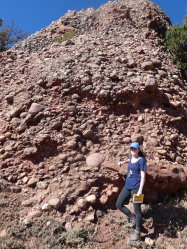Summary
Quantifying the morphologies, morphodynamics, and hydrodynamics of ancient fluvial systems.
The flux of water and sediment to the ocean is governed by tectonic and climatic boundary conditions, which influence spatio-temporal patterns in erosion and sediment routing, as well as fluvial morphologies, morphodynamics, and hydrodynamics. In principle, fluvial stratigraphy provides a physical record of water and sediment transfer across planetary surfaces in the geologic past. However, extracting quantitative information from this record is difficult, and remains a prominent research challenge. Quantitative constraints on the morphologies, morphodynamics, and hydrodynamics of ancient fluvial systems are crucial to: (1) characterise the shape and evolution of ancient fluvial landscapes; (2) reconstruct water and sediment fluxes; and (3) decipher the response of fluvial landscapes to tectonic and climatic perturbations, such as the Paleocene-Eocene Thermal Maximum.
My research applies novel strategies, which include GIS-based techniques, climate modelling results, fieldwork, and numerical modelling, to reconstruct the morphologies, morphodynamics, and hydrodynamics of ancient rivers, as well as erosion and sediment supply. Further, my research aims to tackle this challenge at reach-, catchment-, regional-, and continental-scales. These insights have wide implications for exploring the dynamics of ancient landscapes in response to tectonic and climatic boundary conditions on Earth and other planets.
Supervisors: Dr Alex Whittaker and Prof Peter Allison
BIOGRAPHy
2017 – Present – PhD student, Imperial College London
2016 – 2017 – Nature Publishing Group
2012 – 2016 – MSci Earth Sciences, University College London
Publications
Lyster, S. J., Whittaker, A. C. & Hajek, E. A. (Accepted) The problem of paleo-planforms. Geology DOI:10.1130/G49867.1
Lyster, S. J., Whittaker, A. C., Hajek, E. A. & Ganti, V. (2022) Field evidence for disequilibrium dynamics in preserved fluvial cross-strata: A record of discharge variability or morphodynamic hierarchy? Earth and Planetary Science Letters 579, 117355 DOI:10.1016/j.epsl.2021.117355
Lyster, S. J., Whittaker, A. C., Hampson, G. J., Hajek, E. A., Allison, P. A. & Lathrop, B. A. (2021) Reconstructing the morphologies and hydrodynamics of ancient rivers from source to sink: Cretaceous Western Interior Basin, Utah, USA. Sedimentology 68, 2854–2886 DOI:10.1111/sed.12877
Lyster, S. J., Whittaker, A. C., Allison, P. A., Lunt, D. J. & Farnsworth, A. (2020) Predicting sediment discharges and erosion rates in deep time — examples from the late Cretaceous North American continent. Basin Research 30, 1547–1573 DOI:10.1111/bre.12442
Lyster, S. (2017) Biogeochemistry: a subglacial microbial methane sink. Nature Reviews Chemistry 1, 0070 DOI:10.1038/s41570-017-0070
Bridger, P., Lyster, S. & Hunt, A. (2016) The Paleocene–Eocene Thermal Maximum: investigating the connection between ocean drilling and climate science. ECORD Newsletter 26, 15
Pre-prints
Teaching assistant
Year 1: Structural Geology 1 (Deforming the Earth)
Year 1: Surface Processes
Year 1: Geomaterials
Year 2: Structural Geology 2 (Maps & Structures)
Year 2: Field Geology 2 (Pyrenees field course)
Year 3: South Wales field course
Year 4: Field Geology 5 (Apennines field course)
Publications
Journals
Lyster SJ, Whittaker AC, Allison PA, et al., 2020, Predicting sediment discharges and erosion rates in deep time—examples from the late Cretaceous North American continent, Basin Research, Vol:32, ISSN:0950-091X

